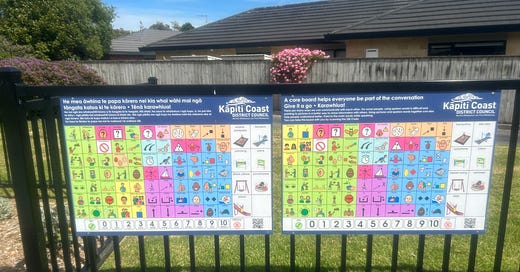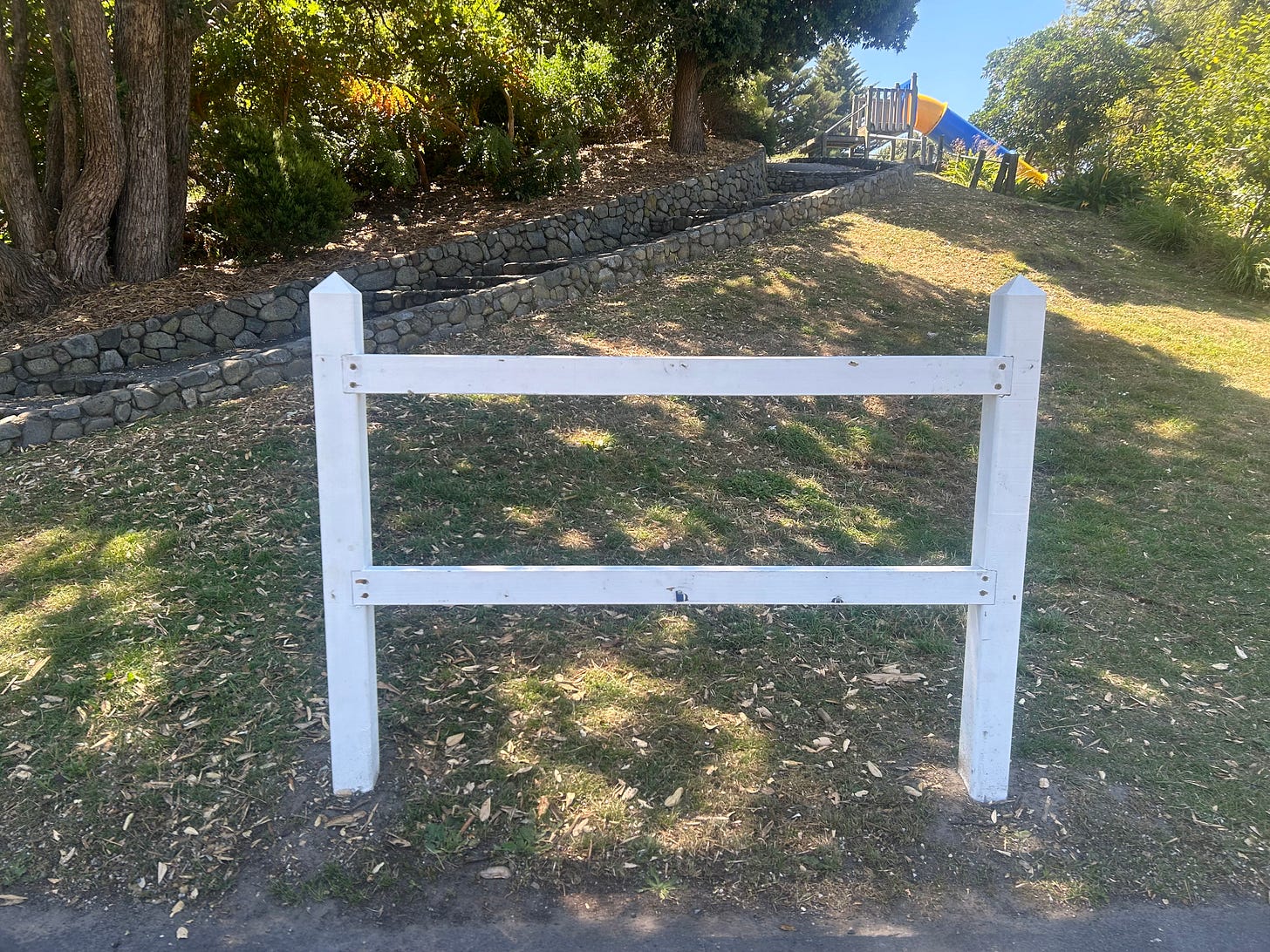It’s been fantastic to receive so many requests from whānau for info on how to lobby council for communication boards in their town. I am more than happy to oblige! So please share this with anyone who is interested, and send me a message if you have any patai 💜 I have included lots of links to helpful articles also, to give you options of what features you value in a communication board the most, so you can approach your council with a clear vision and intent.
Communication boards in Aotearoa: A brief history
You can read my journey with assistive technology, core boards and all things Augmentative & Alternative Communication (AAC) so far here.
The first communication boards in playgrounds I hear about were in Tairāwhiti. What further caught my attention was the fact that they were a collaboration between Gisborne Council and Ministry of Education, via Speech Language Therapist Kristina Pinto. They feature not only in parks but in council facilities like the library and public pools. The boards are proudly bilingual, and care was taken to ensure that translation was checked by local iwi before they were printed. This became a blueprint for future councils to adopt, like the ones we have here in Kāpiti. Another example of a bilingual board can be found in Kowhai Park in Whanganui.
In Hamilton, there is a communication board at the ‘all inclusive’ Claudelands Magic Bridge Playground. This board was actually added after the park was opened, which begs the question “what does all inclusive actually mean?” We can always do better, and add extra layers of accessibility as needs are identified. A park can be physically accessible, but not sensory friendly, it can be bright and welcoming to most but still exclude others. Councils can tend to use accessibility as a buzzword, a box to tick to keep in line with trends and funding streams - so you may have to challenge them on their knowledge of its actual meaning, and who is still left behind in their accessible public spaces.
Anderson Park in Hawkes Bay is a good example of this - their communication boards are not bilingual, but they include QR code to access NZSL videos for each of the symbols on the board. This is another example of a collaborative approach - with council, along with Acorn Autism and Deaf Aotearoa appearing on boards. Te Pua/Keith Park in Auckland also has a similar format.
In Wellington, the much loved Botanic Gardens (ki Paekākā) and Frank Kitts Park (Te Aro Mahana) playgrounds have recently had a major upgrade, with some accessible play equipment (apart from the featured waka ‘Whetuu Maarama,’ which is beautiful but unfortunately not accessible by wheelchair) surface, fencing and picnic area for a cool $3 million. The botanic gardens playground has an English communication board, but nothing for FKP announced so far.
So it doesn’t matter how big the budget is, how committed a council is to accessibility - the key to creating a truly accessible playground is consultation with stakeholder groups - including the disability community and whānau!
In my case, I was lucky that all the ducks were already in a row in my town. Council had just made an investment into making a local park physically accessible and fun for disabled visitors. The design went on to win awards and praise from other councils and the public, so I think they were quite motivated to build on this. They were open to hearing about other ideas to make the park even more accessible, and to use these ideas in other parks in the region. I was able to connect them with Kristina the SLT in Tairāwhiti, as well as a local SLT and TalkLink Trust.
Communication Boards fit within Kāpiti Coast District Council’s vision to support tangata whenua and tangata whaikaha also, with the bilingual aspect of the boards.

Ground work - get googling!
🤔 Before you approach your council, it’s good to do some groundwork. Have a look at the examples of communication boards currently being included around the country. Take note of the disability groups who have been part of the collaboration.
🤔 Think about the communities that would benefit from a communication board in your community, outside of your own experience. So my experience is primarily with neurodivergent tamariki and rangatahi. Outside this, the boards could benefit visitors to parks such as disabled adults, people with a brain injury, stroke survivor, people with aphasia, migrant/non English speakers, people who are Deaf or hard of hearing, etc.
🤔 Familiarise yourself with your council website. Search for policies that show a commitment to accessibility in your town, to use as examples in any communications with them. Start building a case that shows that there is demand for such a support in the community
🤔 Have a look at what Advisory Group exist, and which ones link with the disabled community. If there is an Accessibility/Disability Advisory Group, this is a great first point of contact to raise the need for communication boards. Give examples of locations that would benefit from a communication board
🤔 Look for opportunities for public consultation on public spaces - eg upcoming upgrades to playgrounds, parks etc often have online surveys you can fill in and suggest that they include communication boards in their budget. Long and short term plans/visions for your town/city should have a section on improved accessibility that you can suggest they include communication boards. Use phrases like ‘increase accessibility,’ ‘improve physical and mental wellbeing,’ ‘enhance social cohesion,’
🤔 Contact TalkLink Trust - their Facebook page shares lots of examples of communication boards in places around Aotearoa. They might give you some ideas about locations (not just playgrounds) that would benefit from a communication board being installed. Think big - libraries, pools and other council facilities, parks, walks, tourist attractions too.
🤔 As I mentioned earlier, some there are also a couple of examples of councils collaborating with private funders/trusts and non-profit organisations in the disability sector to get the boards. There may be other ways to fund a board, but do keep in mind the location and maintenance (eg graffiti/damage) and whose responsibility this will be.
For the boards in Kāpiti, part of the process of installing the boards included a tour of the proposed sites, choosing the right height and placement of the boards so that they were accessible but also not obstructing any other features, for example - what might look like a good spot for a board might block an entrance or footpath, or it might not be on the right surface to dig into without disturbing the area around it. What I thought was a good spot was not necessarily the best spot according to someone from the parks maintenance team, so it is slightly more complicated than you might imagine!
We also had a recent incident where one of the boards was damaged forceably removed. I want to say that it wasn’t targeted, all the other seven sites haven’t been touched and this one is in an isolated park with no CCTV or lights - and it was in the holidays. When the boards were replaced, the maintenance team made sure the posts were cemented into the ground, and the backing was reinforced so it couldn’t be kicked in 🤦♀️ Just another consideration when your boards are being installed!
How to request communication boards
Once you have a point of contact, and your Kete jam-packed with knowledge, it’s time to write a letter requesting a communication board. Some tips:
Introduce yourself and your whānau - and your connection to this kaupapa. Include the community you live in, and the public spaces that are important to you
eg. My name is …. I am parent to ….. who has a diagnosis of …. This means that they have issues with…..
We live in …. and love to explore the parks, playgrounds etc in …..
Give the reader an insight into how navigating these spaces can be difficult for your child, and how a communication board could help ease this.
eg. My child loves the outdoors and exploring the playground. They can get overwhelmed when it is noisy and crowded in this space. A communication board would support my Childs communication style and allow them to tell us what they need, how they feel, what they want to do next.
Expand as much as you like, but follow it up with phrases like
A communication board would allow my child to confidently navigate and enjoy the playground experience, alongside their sibling/s and peers.
Be polite, offer suggestions and stay open to being contacted by council to discuss this further. Give them links to news stories that promote the communication board and the council initiative equally! (Appeal to their ego, everyone loves good publicity!) Make sure to point them in the direction of TalkLink Trust, who can advise them of their options.
What if they say no?!
Keep trying. Keep contributing to council consultations that involve public spaces. Encourage other whānau, disabled people and local support groups to do the same. Share your journey with your support networks - social media is really good to find allies and encourage them to lobby council as well. Use your social media as a platform for encouraging conversations around disability, inclusion, accessibility, communication, sensory needs etc. You never know who will read it and take notice.
I’d like to try and compile some feedback from visitors to parks with communication boards to hear what an impact it has had on their ability to visit these spaces - not just for my own interest, but so I can share it as an encouragement for councils to fund these sort of supports for the disabled community. For my whānau it has helped us feel ‘visible’ in spaces like playgrounds where we often felt excluded and unwelcome. My daughter can use her voice loud and proud thanks to AAC and the more visible this form of communication is in our communities, the better! So if you have any feedback, please let me know!
Anyways - I hope some/all of this has been helpful! I wish you the very best with your journey, and as I said earlier, send me any patai/questions and I will do my best to support you.




